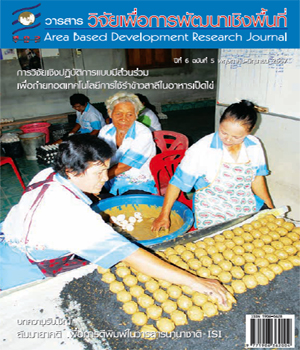การวิจัยเชิงปฏิบัติการแบบมีส่วนร่วม เพื่อถ่ายทอดเทคโนโลยี การใช้รำข้าวสาลีในอาหารเป็ดไข่
Main Article Content
Abstract
งานวิจัยครั้งนี้มีวัตถุประสงค์เพื่อศึกษาระดับที่เหมาะสมของการใช้รำข้าวสาลีในอาหารเป็ดไข่ รวบรวมกรรมวิธีการผลิตไข่เค็มตามแบบภูมิปัญญาท้องถิ่นและถ่ายทอดเทคโนโลยีสู่ชุมชน เป็นการวิจัยและพัฒนาที่ใช้การวิจัยแบบผสมผสาน ประกอบด้วย การวิจัยทดลองภาคสนามและใช้วิธีวิทยาการวิจัยเชิงปฏิบัติการแบบมีส่วนร่วมกับเกษตรกรเลี้ยงเป็ดไข่และผลิตไข่เค็ม จำนวน 30 ราย โดยคัดเลือกแบบเจาะจงจากเกษตรกรเลี้ยงเป็ดไข่ตั้งแต่ 50 ตัวขึ้นไปในพื้นที่อำเภอไชยา จังหวัดสุราษฏร์ธานี ใช้เครื่องมือสำคัญในการเก็บรวบรวมข้อมูล คือ การสัมภาษณ์เชิงลึกผู้ให้ข้อมูลหลัก การสนทนากลุ่ม และฝึกอบรมเชิงปฏิบัติการเรื่องการเลี้ยงเป็ดไข่และการผลิตไข่เค็ม ส่วนการวิจัยทดลองภาคสนาม สัตว์ทดลองได้แก่เป็ดลูกผสมกากีแคมป์เบลล์เพศเมีย อายุ 21 สัปดาห์ จำนวน 225 ตัว วางแผนการทดลองแบบสุ่มสมบูรณ์อาหารทดลองมี 5 สูตร ผสมรำข้าวสาลีระดับร้อยละ 0 5 10 15 และ 20 โดยน้ำหนัก ตามลำดับ สูตรละ 3 ซ้ำๆ ละ 15 ตัว วิเคราะห์ข้อมูลโดยวิธี Analysis of Variance และเปรียบเทียบความแตกต่างระหว่างค่าเฉลี่ยของกลุ่มโดยวิธี Duncan,s New Multiple Range Test ผลการศึกษาสมรรถภาพการผลิตและคุณภาพไข่ พบว่า ต้นทุนค่าอาหารต่อการผลิตไข่ 1 โหล (25.91 บาท) ของอาหารสูตรที่ผสมรำข้าวสาลีร้อยละ 5 โดยน้ำหนัก มีความแตกต่างอย่างมีนัยสำคัญทางสถิติ (P<0.05) เมื่อเปรียบเทียบกับอาหารเป็ดไข่สำเร็จรูปทางการค้า แต่ประสิทธิภาพการเปลี่ยนอาหารต่อไข่ 1 โหล ผลผลิตไข่ (ร้อยละ/วัน) น้ำหนักไข่ (กรัม/ฟอง) ความหนาของเปลือกไข่ (มิลลิเมตร) สีไข่แดง และค่าฮอกยูนิต ไม่มีความแตกต่างอย่างมีนัยสำคัญทางสถิติ (P>0.05) สรุปได้ว่า การใช้อาหารผสมรำข้าวสาลีร้อยละ 5 โดยน้ำหนัก ส่งผลให้สมรรถภาพการผลิตและคุณภาพไข่ดีกว่าอาหารทดลองกลุ่มอื่นๆ และไม่พบเป็ดตายตลอดการทดลอง การรวบรวมกรรมวิธีการผลิตไข่เค็มตามแบบภูมิปัญญาท้องถิ่นพบว่า ไข่ที่ใช้ผลิตไข่เค็มต้องเป็นไข่สดในพื้นที่อำเภอไชยาที่เลี้ยงด้วยสูตรอาหารเฉพาะ พอกด้วยดินจอมปลวกที่ผสมเกลืออัตราส่วน 3:1 แล้วคลุกขี้เถ้าแกลบ หมักไว้ 14 วัน จะทำให้ไข่เค็มที่ได้ไข่แดงสีแดงเข้ม มีมันเยิ้ม ไข่ขาวนุ่มและเค็มพอเหมาะ ได้ถ่ายทอดผลการศึกษาให้กับเกษตรกรเลี้ยงเป็ดและผลิตไข่เค็ม จัดทำคู่มือกรรมวิธีการผลิตไข่เค็มตามแบบภูมิปัญญาท้องถิ่น พร้อมจัดตั้งฟาร์มตัวอย่างเป็นแหล่งเรียนรู้ในชุมชนเพื่อขยายผลการวิจัยเรื่องการใช้ประโยชน์จากรำข้าวสาลีซึ่งเป็นวัสดุเหลือใช้ทางการเกษตรเป็นอาหารเป็ดระยะไข่อายุ 22-48 สัปดาห์และใช้พื้นที่ฟาร์มตัวอย่างเป็นจุดสาธิตการผลิตไข่เค็มให้ได้ตามมาตรฐานผลิตภัณฑ์ชุมชน
The Participatory Action Research to Technology Transfer of the Use of Wheat Bran for Laying Duck.
The research aimed to study the effect of the use of wheat bran for laying duck diet, collected for Chiya salted eggs process along local wisdom and technology transfer to the community. The mixed method research used experimental research and the participatory action research methodology to study 30 laying duck farmers and salted egg manufacturers which raised more than 50 laying ducks in Chiya district of Suratthani province. A total 225 female crossbred Khaki Campbell ducks were sampled for experimental research. The research to identify source of knowledge by using primary data analysis, In-depth interview from key informants, focus groups and workshop title: Raising laying ducks and salted egg process. The study was using statistical treatment of the data was done by analysis of variance (ANOVA) and data was analyses by Duncan’s New Multiple Range test. According to the finding, it was found that the study was using completely randomized design with 5 levels of wheat bran (0, 5, 10, 15 and 20%) in laying duck diets, Khaki Campbell ducks were randomly allotted to treatments of 15 laying ducks per pen with 3 replications per treatment. The results of study showed that there was significant difference (p<0.05) in feed cost of 12 eggs production (25.91 bath) compared with commercial feed. There was non significant difference (P>0.05) in feed conversion ratio (per 12 eggs), egg production (percent per day) ,egg weight (gram), shell thickness (millimeter) and yolk color. The results also indicated that production performance at 5% wheat bran of weight feed is the highest production performance and egg quality in 22-48 weeks of age duck. There were no mortality. According to the production Chiya Salted Eggs along local wisdom, it was found that the productive standard of Chiya Salted Eggs is yolk which should be dark red color and oily. In addition, the quantity of yolk has a higher level than albumen and should not be too salty. The researchers were collected for manuals and guides to processing Chiya salted eggs along local wisdom and the community learning farm center has been established utilization of agricultural by product are wheat bran in laying duck 22-48 weeks of age. The researchers used the community learning farm center to demonstrate salted egg process.
Article Details
Area Based Development Research Journal values copyright protection and licensing to safeguard author rights and facilitate the appropriate dissemination of research. Our policies ensure openness, accessibility, and attribution. Authors retain copyright ownership, and articles are published under a Creative Commons Attribution License (CC BY), allowing sharing, adaptation, and proper attribution. Authors have the freedom to publish under the CC BY license, granting broad reuse and distribution permissions. The journal supports posting articles on third-party repositories, adhering to institutional and funding restrictions. Author guidelines detail copyright and licensing requirements, empowering authors with knowledge about their rights and responsibilities. These policies cultivate an environment of collaboration, openness, and responsible sharing, benefiting authors and the research community while honoring intellectual property rights.
